Influence of Surfactant Types on the Anti-Corrosion Performance of Phosphate Chemical Conversion Coated Mg-8wt.%Li Alloy
Abstract
:1. Introduction
2. Materials and Methods
2.1. Sample Treatment
2.2. Preparation of Surface Coatings
2.3. Microstructural Analysis and Characterization of Surface Coatings
2.4. Electrochemical Measurements and Hydrogen Evolution
2.5. Failure Analysis
3. Results and Discussion
3.1. Microstructural Analysis
3.2. Characterization of the Coating Layers
3.3. Electrochemical Testing
3.4. Corrosion Morphology
4. Conclusions
- (1)
- The corrosion resistance of the AES-coated and AEO-coated samples is clearly higher than that of the reference sample coated without a surfactant.
- (2)
- For the AES-coated and AEO-coated samples, the coating layers have a petal-shaped structure and are composed of leaf-like particles, whilst the coating layer of the AES-coated sample is relatively dense due to the smaller size of the petal-shaped structure.
- (3)
- The measurements of electrochemical data and hydrogen evolution demonstrate that the corrosion resistance of the AES-coated sample is better than that of the AEO-coated sample.
- (4)
- For the AES-coated and AEO-coated samples, the film layers have better corrosion protectability on the substrate when immersed for less than 6 h. When the soaking time increases, the corrosion protectability of the two types of coating layers will be gradually degraded.
Author Contributions
Funding
Institutional Review Board Statement
Informed Consent Statement
Data Availability Statement
Conflicts of Interest
References
- Xu, H.; Liu, J.A.; Xie, S.S. Preparation and Processing Technology of Magnesium Alloy; Metallurgical Industry Press: Beijing, China, 2007. [Google Scholar]
- Chang, Y.Z.; Li, J.C.; Xie, W.B. Production Technology and Application of Magnesium Alloy; Metallurgical Industry Press: Beijing, China, 2018. [Google Scholar]
- Li, Y.K.; Zha, M.; Rong, J.; Jia, H.L.; Jin, Z.Z.; Zhang, H.M.; Ma, P.K.; Xu, H.; Feng, T.T.; Wang, H.Y. Effect of large thickness-reduction on microstructure evolution and tensile properties of Mg-9Al-1Zn alloy processed by hard-plate rolling. J. Mater. Sci. Technol. 2021, 88, 215–225. [Google Scholar] [CrossRef]
- Xu, T.C.; Yang, Y.; Peng, X.D.; Song, J.F.; Pan, F.S. Overview of advancement and development trend on magnesium alloy. J. Magnes. Alloys 2019, 7, 536–544. [Google Scholar] [CrossRef]
- Cai, X.; Qiao, Y.X.; Xu, D.K.; Li, C.Q.; Yang, L.L.; Zhou, H.L. Research progress on strengthening behavior of magnesia-lithium alloys. Mater. Rep. 2019, 33, 374–379. [Google Scholar]
- Wu, R.Z.; Zhang, M.L. Reviews on the influences of alloying elements on the microstructure and mechanical properties of MgLi base alloys. Rev. Adv. Mater. Sci. 2010, 24, 14–34. [Google Scholar]
- Wang, B.J.; Xu, K.; Xu, D.K.; Cai, X.; Qiao, Y.X.; Sheng, L.Y. Anisotropic corrosion behavior of hot-rolled Mg-8Li wt.% alloy. J. Mater. Sci. Technol. 2020, 53, 102–111. [Google Scholar] [CrossRef]
- Hou, J.Y.; Wang, B.J.; Xu, D.K.; Cui, L.J.; Sun, J. Effect of surfactants on the corrosion protectability of calcium phosphate conversion coatings on duplex structured Mg-8Li (in Wt.%) alloy. Coatings 2022, 12, 1182. [Google Scholar] [CrossRef]
- Peng, X.; Liu, W.C.; Wu, G.H. Alloying of magnesia-lithium alloy and its application. Trans. Nonferrous Metal. Soc. China 2021, 31, 3024–3043. [Google Scholar]
- Song, D.L.; Jing, X.Y.; Wang, J.; Lu, S.S.; Yang, P.P.; Wang, Y.L.; Zhang, M.L. Microwave- assisted synthesis of lanthanum conversion coating on Mg-Li alloy and its corrosion resistance. Corros. Sci. 2011, 53, 3651–3656. [Google Scholar] [CrossRef]
- Yang, L.H.; Zhang, M.L.; Li, J.Q.; Yu, X.; Niu, Z.Y. Stannate conversion coatings on Mg–8Li alloy. J. Alloys Compd. 2008, 471, 197–200. [Google Scholar] [CrossRef]
- Esmaily, M.; Svensson, J.E.; Fajardo, S.; Birbilis, N.; Frankel, G.S.; Virtanen, S.; Arrabal, R.; Thomas, S.; Johansson, L.G. Fundamentals and Advances in Magnesium Alloy Corrosion. Prog. Mater. Sci. 2017, 89, 92–193. [Google Scholar] [CrossRef]
- Yang, Y.X.; Fang, Z.; Liu, Y.H.; Hou, Y.C.; Wang, L.G.; Zhou, Y.F.; Zhu, S.j.; Zeng, R.C.; Zheng, Y.F.; Guan, S.K. Biodegradation, hemocompatibility and covalent bonding mechanism of electrografting polyethylacrylate coating on Mg alloy for cardiovascular stent. J. Mater. Sci. Technol. 2020, 46, 114–126. [Google Scholar] [CrossRef]
- Tao, X.W.; Wang, Z.Z.; Ba, Z.X.; Kong, S.X.; Hu, Q.X. Research progress in ion implantation surface modification of magnesium alloys. Mater. Rep. 2014, 28, 112–115. [Google Scholar]
- Makoto, H.; Yutaka, M.; Koji, M.; Katsuji, N.; Teruto, K. Development of laser surface treatment with excellent corrosion resistance and conductivity performance on magnesium alloy products. Mater. Sci. Forum. 2010, 962, 1960–1963. [Google Scholar]
- Setiawan, A.P.; Rachman, M.D. An Investigation of pulse anodization duty ratio and sealing treatment on the corrosion behavior of the anodic coating layer in magnesium AZ31B. Corros. Sci. Tenchnol. 2021, 20, 45–51. [Google Scholar]
- Hatef, S.; Mohammad, A.M. Physical vapor deposition assisted diffusion bonding of Al alloy to Mg alloy using silver interlayer. Met. Mater. Int. 2020, 27, 4132–4141. [Google Scholar]
- Meng, X.; Wang, J.L.; Zhang, J.; Niu, B.L.; Gao, X.H.; Yan, H. Electroplated super-hydrophobic Zn-Fe coating for corrosion protection on magnesium alloy. Trans. Nonferrous Met. Soc. China 2022, 32, 3250–3258. [Google Scholar] [CrossRef]
- Khazeni, D.; Saremi, M.; Soltani, R. Development of HA-CNTs composite coating on AZ31 Magnesium alloy by cathodic electrodeposition. Part 2: Electrochemical and in-vitro behavior. Ceram. Int. 2019, 45, 11186–11194. [Google Scholar] [CrossRef]
- Cai, Y.R.; Wang, X.D.; Wan, L.L.; Yang, J.X.; Gao, Y.F. Preparation of antimony-doped stannate chemical conversion coating on AZ31B Mg alloy. Trans. Indian Inst. Met. 2020, 73, 1891–1898. [Google Scholar] [CrossRef]
- Luan, J.Y.; Wang, B.J.; Xu, D.K.; Sun, J. Research progress in corrosion protection of magnesium lithium alloy. Mater. Rep. 2020, 34, 441–446. [Google Scholar]
- Jin, H.S.; Wang, R.C.; Peng, C.Q.; Ping, Y.; Shi, K.; Chen, B. Research progress of chemical conversion film on magnesium alloy surface. Trans. Nonferrous Met. Soc. China 2011, 21, 2049–2059. [Google Scholar]
- Zeng, R.C.; Kong, L.H.; Chen, J.; Cui, H.Z.; Liu, C.L. Research progress on surface modification of magnesium alloys for medical applications. Trans. Nonferrous Met. Soc. China 2011, 21, 35–43. [Google Scholar]
- Amini, R.; Sarabi, A.A. The corrosion properties of phosphate coating on AZ31 magnesium alloy: The effect of sodium dodecyl sulfate (SDS) as an eco-friendly accelerating agent. Appl. Surf. Sci. 2011, 257, 7134–7139. [Google Scholar] [CrossRef]
- Phuong, N.V.; Lee, K.; Chang, D.; Kim, M.; Lee, S.; Moon, S. Zinc phosphate conversion coatings on magnesium alloys: A review. Met. Mater. Int. 2013, 19, 273–281. [Google Scholar] [CrossRef]
- Thomas, R.; Umapathy, M.J. Environment friendly nano silicon dioxide accelerated zinc phosphate coating on mild steel using a series of surfactants as additives. Silicon 2017, 9, 675–688. [Google Scholar] [CrossRef]
- Maurya, R.; Siddiqui, A.R.; Balani, K. An environment-friendly phosphate chemical conversion coating on novel Mg-9Li-7Al-1Sn and Mg-9Li-5Al-3Sn-1Zn alloys with remarkable corrosion protection. Appl. Surf. Sci. 2018, 443, 429–440. [Google Scholar] [CrossRef]
- Yan, W.; Chen, Z.; Yu, Q.; Zhu, W.; Wang, H.; Du, B.Q. Effects of fatty alcohol polyoxyethylene ether AEO on PbO2 structure and electrodeposition behavior. J. Electrochem. Soc. 2016, 163, D414–D420. [Google Scholar] [CrossRef]
- Wang, B.J.; Xu, D.K.; Wang, S.; Xu, X.B.; Han, E.H. Effect of phosphate conversion film on fatigue and corrosion fatigue behavior of an as-rolled Mg-3.08Zn-0.83Al (in wt.%) alloy. J. Iron Steel Res. Int. 2023, 30, 2557–2565. [Google Scholar] [CrossRef]
- Xu, Y.D.; Qi, S.; Wang, L.; Shi, M.; Ding, N.; Pang, Z.C.; Wang, Q.; Peng, X.D. Effects of hydroxylamine sulfate and sodium nitrite on microstructure and friction behavior of zinc phosphating coating on high carbon steel. Chin. J. Chem. Phy. 2015, 28, 197–202. [Google Scholar] [CrossRef]
- Yang, Q.X.; Tabish, M.; Wang, J.B.; Zhao, J.M. Enhanced corrosion resistance of layered double hydroxide films on Mg alloy: The key role of cationic surfactant. Materials 2022, 15, 2028. [Google Scholar] [CrossRef]
- Li, J.Z.; Guo, R.G.; Tang, C.B. Study on corrosion resistance modification of vanadate conversion film on magnesium alloy surface by OP10. Mater. Pro. 2017, 50, 52–55. [Google Scholar]
- Jothi, S.; Ruan, D.; Yaqin, L.; Rasu, E.; Jianshe, L. Influence of surfactants on the corrosion properties of chromium-free electroless nickel deposit on magnesium alloy. Surf. Rev. 2012, 19, 1250025. [Google Scholar]
- Gou, Y.N.; Li, X.Y. Effect of surfactants on zinc leaching of magnesium alloy. Surf. Technol. 2012, 41, 51–53. [Google Scholar]
- Yang, X.Y.; Yang, Y.T.; Lu, X.P.; Zhang, T.; Wang, F.H. Research progress of corrosion inhibitors for magnesium alloys. Trans. Nonferrous Met. Soc. China 2022, 42, 435–440. [Google Scholar]
- Shetha, D.; Manik, C.M.; Cv, S. Performance evaluation of nano additives and surfactants on the properties of electroless nickel phosphorous coating on aluminium-magnesium Alloy. Mater. Sci. Engr. 2018, 376, 012048. [Google Scholar]
- Mohd, I.A.; Dineshsingh, G.T. Influence of surfactant: Using electroless ternary nanocomposite coatings to enhance the surface properties on AZ91 magnesium alloy. Surf. Interfaces 2017, 7, 20–28. [Google Scholar]
- Mohammed, S. Characterization of Ni-P coating on AZ91D magnesium alloy with surfactants and nano-additives. J. Magnes. Alloys 2014, 2, 293–298. [Google Scholar]
- Sudagar, J.; Lian, J.S.; Jiang, Z.H.; Li, G.Y.; Elansezhian, R. The performance of surfactant on the surface characteristics of electroless nickel coating on magnesium alloy. Prog. Org. Coat. 2012, 74, 788–793. [Google Scholar] [CrossRef]
- Frignani, A.; Grassi, V.; Zanotto, F.; Zucchi, F. Inhibition of AZ31 Mg alloy corrosion by anionic surfactants. Corros. Sci. 2012, 63, 29–39. [Google Scholar] [CrossRef]
- Moha, I.A.; Dinesh, S.G.T. Study of mechanical properties of electroless nickel-P phosphorus coatings with influence of surfactant on AZ91 Magnesium Alloy. Adv. Eng. Forum. 2016, 4365, 56–63. [Google Scholar]
- Sargolzaei, B.; Arab, A. Synergism of CTAB and NLS surfactants on the corrosion inhibition of mild steel in sodium chloride solution. Mater. Today. Commum. 2021, 29, 309–318. [Google Scholar] [CrossRef]
- Wang, B.J.; Hou, J.Y.; Luan, J.Y.; Xu, D.K.; Sun, H.J.; Sun, J. The corrosion behaviors of an as-rolled Mg-8Li (in wt.%) alloy in two differently concentrated NaCl solutions. Coatings 2022, 12, 406. [Google Scholar] [CrossRef]
- Zhu, Y.H.; Zhi, Y.S.; Fan, J.W. Industrial Water Treatment; Tong Ji University Press: Shanghai, China, 2016. [Google Scholar]
- Wang, G.; Cao, N.; Wang, Y. Characteristics and corrosion studies of zinc–manganese phosphate coatings on magnesium-lithium alloy. RSC Adv. 2014, 4, 59772–59778. [Google Scholar] [CrossRef]
- Song, Y.W.; Shan, D.Y.; Chen, R.S.; Zhang, F.; Han, E.H. Formation mechanism of phosphate conversion film on Mg–8.8 Li alloy. Corros. Sci. 2009, 51, 62–69. [Google Scholar] [CrossRef]
- Wang, Y.H.; Yang, W.; Yang, W.M.; Luo, L.M. Effect of AES anionic surfactant on the microstructure and wettability of coal. Energy 2024, 289, 130118. [Google Scholar] [CrossRef]
- Atrens, A.D.; Gentle, I.; Atrens, A. Possible dissolution pathways participating in the Mg corrosion reaction. Corros. Sci. 2015, 92, 173–181. [Google Scholar] [CrossRef]
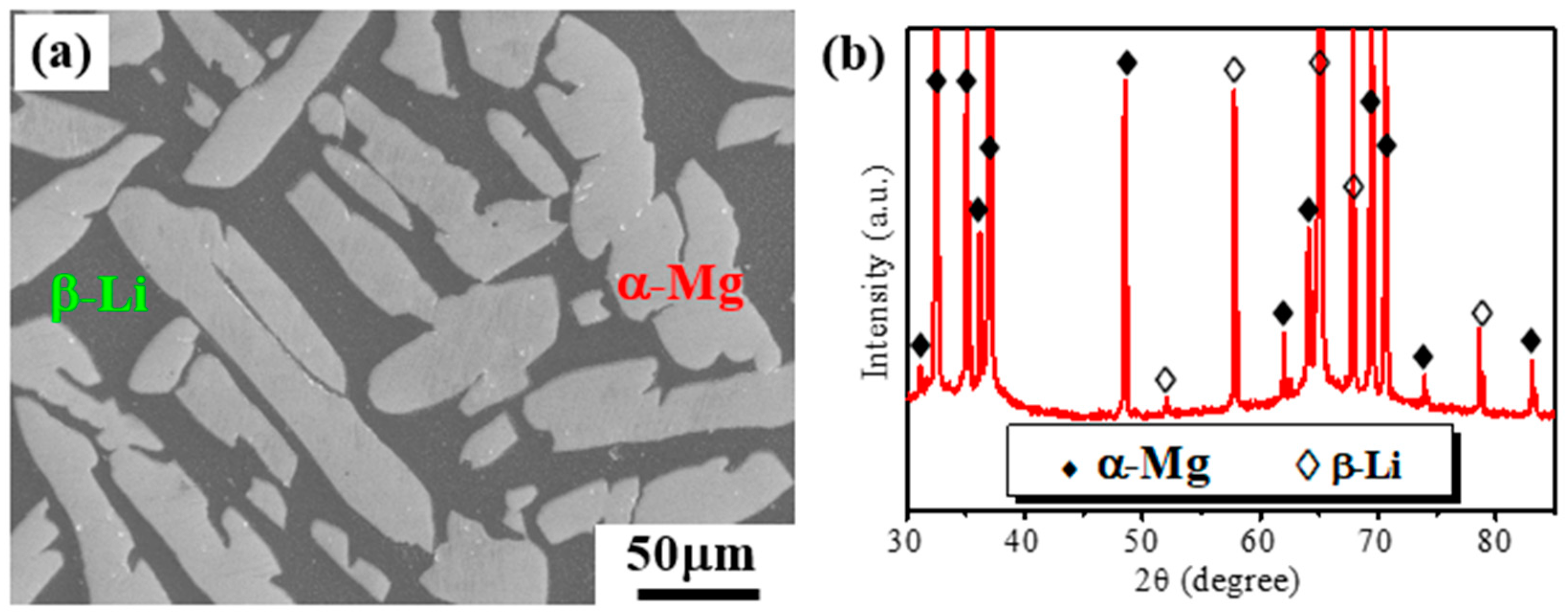
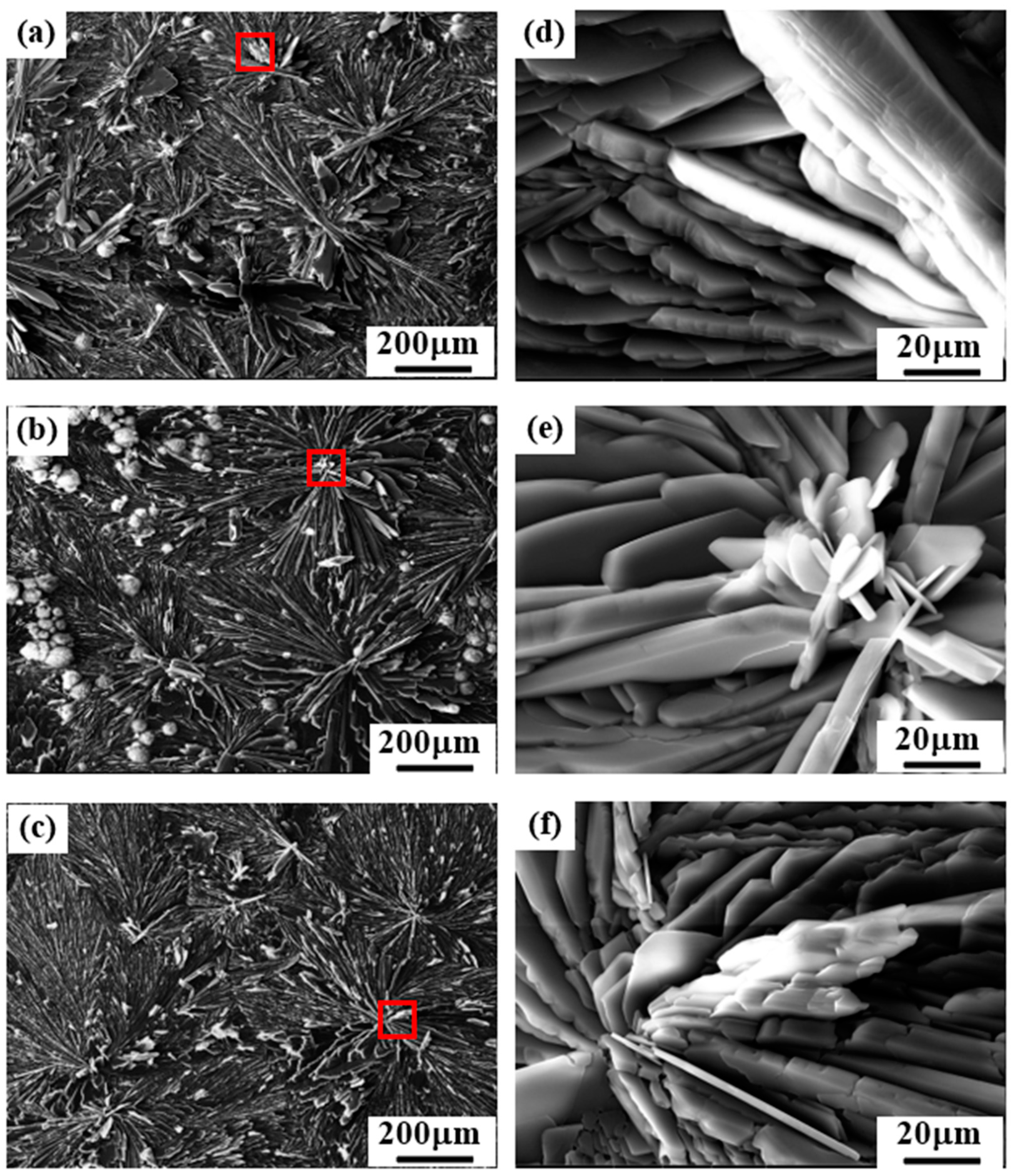

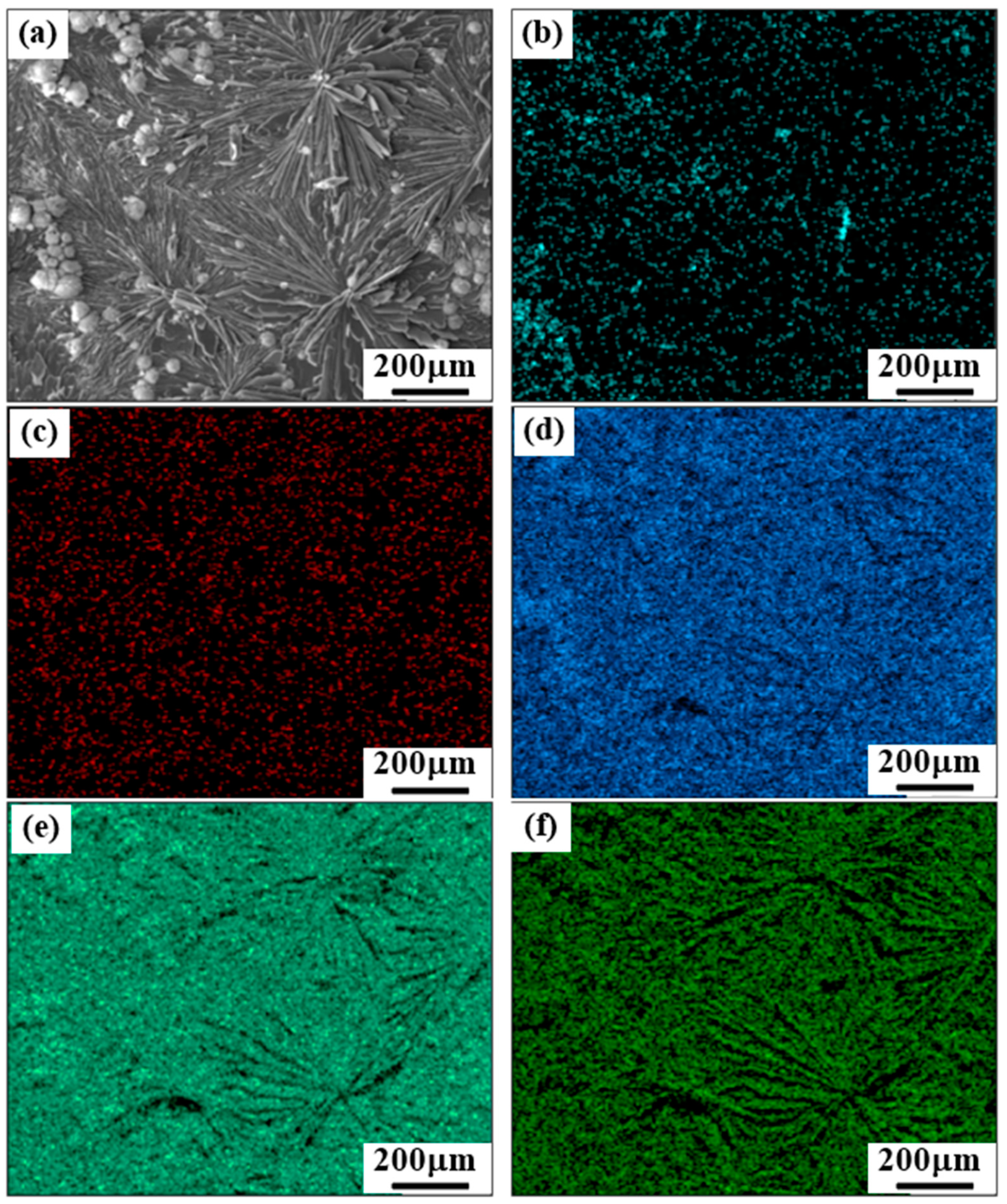
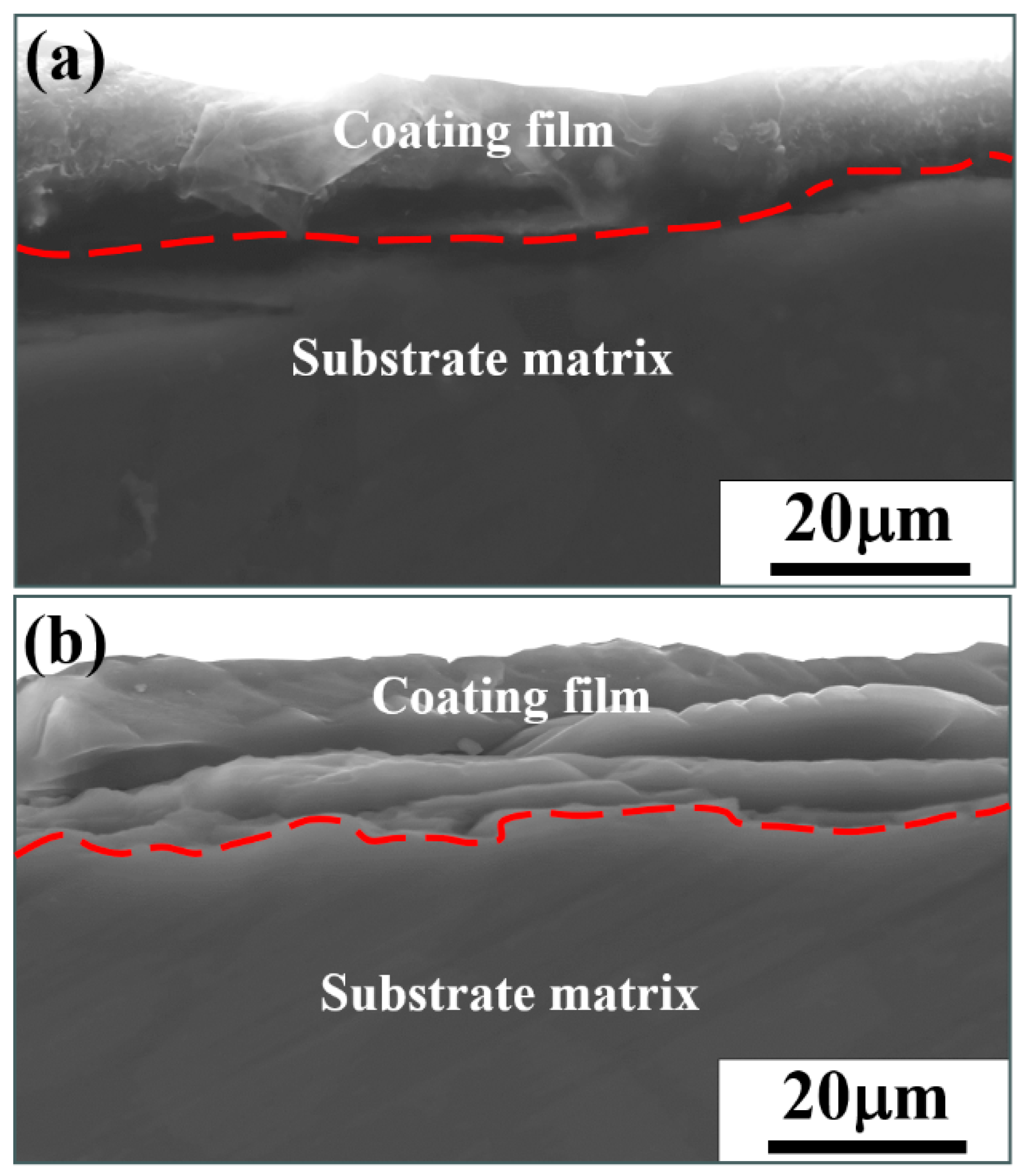

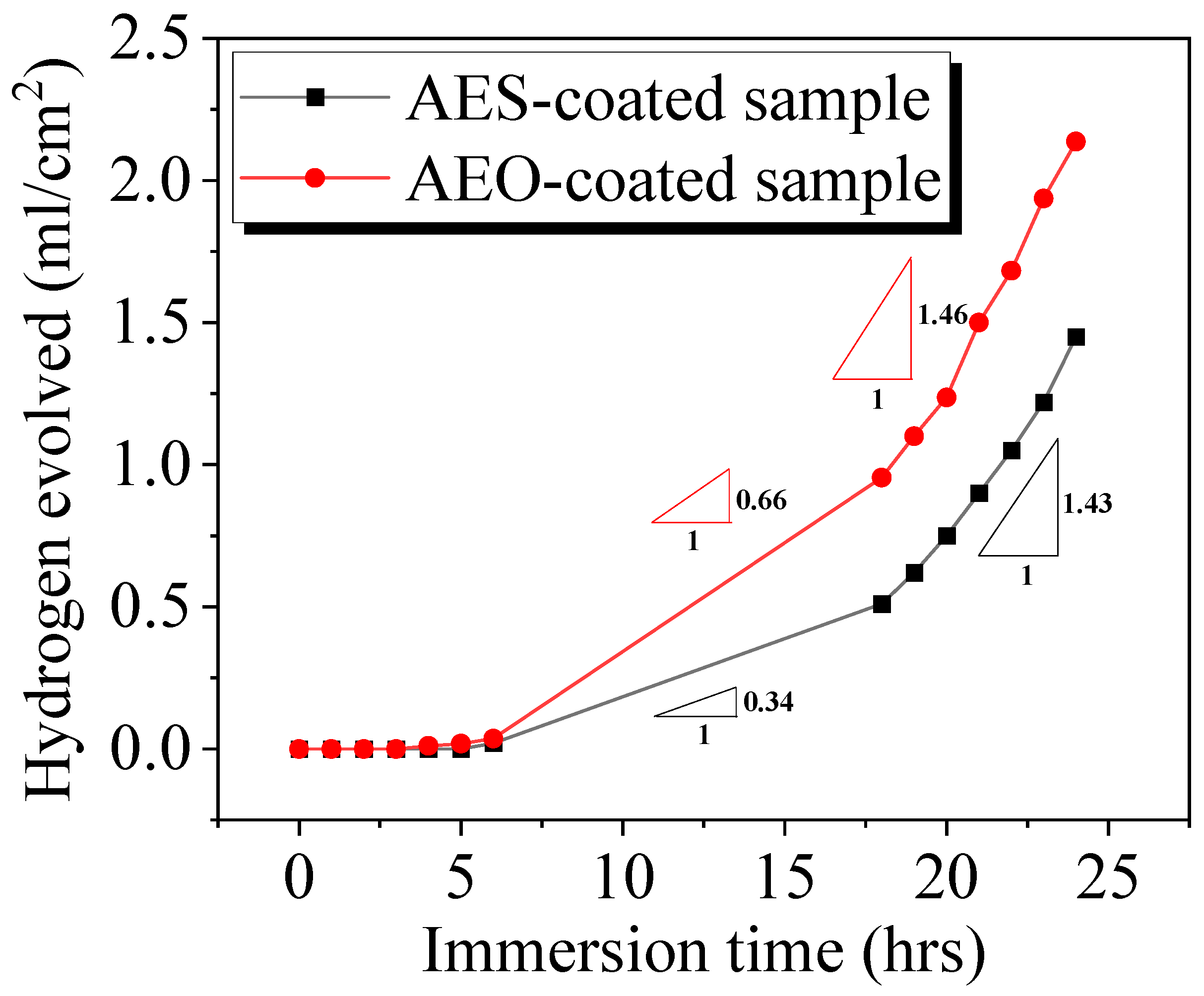



| Sample Conditions | icorr (mA·cm−2) | Ecorr (VSCE) |
|---|---|---|
| AES-coated | 7.8 ± 1.3 | −1.56 ± 0.01 |
| AEO-coated | 11.7 ± 1.5 | −1.58 ± 0.01 |
| Coated without surfactant | 36.2 ± 1.8 | −1.58 ± 0.01 |
| Sample Conditions | Rs (Ω cm2) | Ydl (μF) | ndl | Rct (Ω cm2) |
|---|---|---|---|---|
| AES-coated | 17.1 ± 0.7 | 29.9 ± 1.6 | 0.68 ± 0.12 | 5751 ± 250 |
| AEO-coated | 18.1 ± 0.8 | 33.4 ± 1.8 | 0.69 ± 0.13 | 4575 ± 235 |
| Coated without surfactant | 15.3 ± 0.6 | 35.0 ± 1.4 | 0.70 ± 0.15 | 2412 ± 185 |
Disclaimer/Publisher’s Note: The statements, opinions and data contained in all publications are solely those of the individual author(s) and contributor(s) and not of MDPI and/or the editor(s). MDPI and/or the editor(s) disclaim responsibility for any injury to people or property resulting from any ideas, methods, instructions or products referred to in the content. |
© 2024 by the authors. Licensee MDPI, Basel, Switzerland. This article is an open access article distributed under the terms and conditions of the Creative Commons Attribution (CC BY) license (https://creativecommons.org/licenses/by/4.0/).
Share and Cite
Cui, L.; Wang, B.; Hou, J.; Xu, D.; Sun, J. Influence of Surfactant Types on the Anti-Corrosion Performance of Phosphate Chemical Conversion Coated Mg-8wt.%Li Alloy. Coatings 2024, 14, 641. https://doi.org/10.3390/coatings14050641
Cui L, Wang B, Hou J, Xu D, Sun J. Influence of Surfactant Types on the Anti-Corrosion Performance of Phosphate Chemical Conversion Coated Mg-8wt.%Li Alloy. Coatings. 2024; 14(5):641. https://doi.org/10.3390/coatings14050641
Chicago/Turabian StyleCui, Liji, Baojie Wang, Jiyu Hou, Daokui Xu, and Jie Sun. 2024. "Influence of Surfactant Types on the Anti-Corrosion Performance of Phosphate Chemical Conversion Coated Mg-8wt.%Li Alloy" Coatings 14, no. 5: 641. https://doi.org/10.3390/coatings14050641
APA StyleCui, L., Wang, B., Hou, J., Xu, D., & Sun, J. (2024). Influence of Surfactant Types on the Anti-Corrosion Performance of Phosphate Chemical Conversion Coated Mg-8wt.%Li Alloy. Coatings, 14(5), 641. https://doi.org/10.3390/coatings14050641








